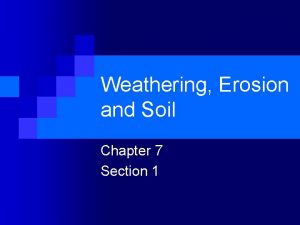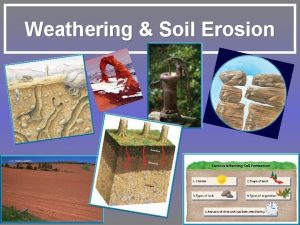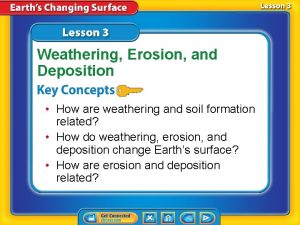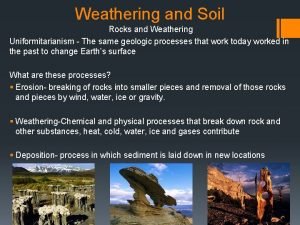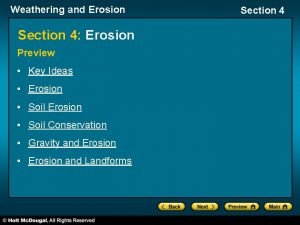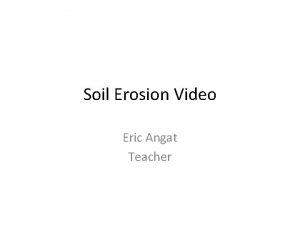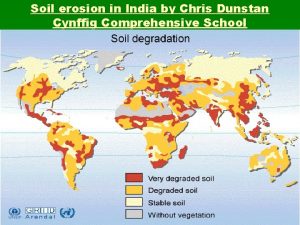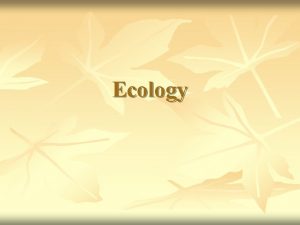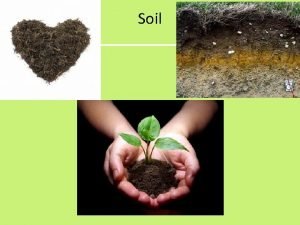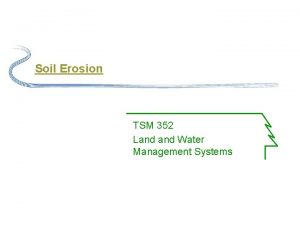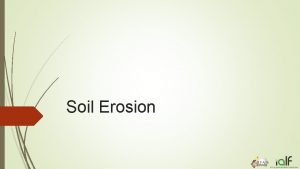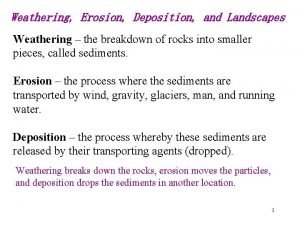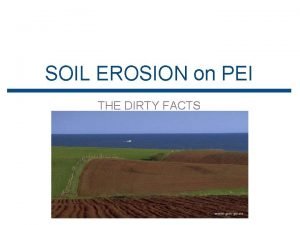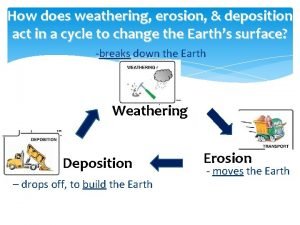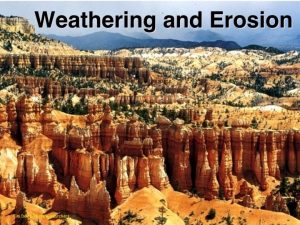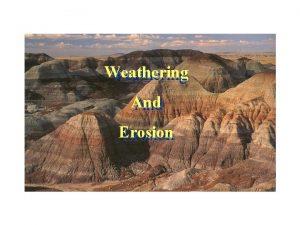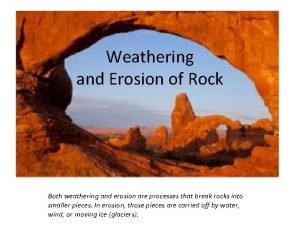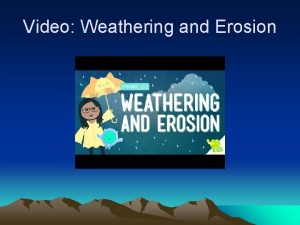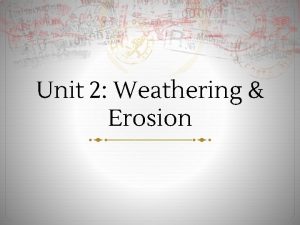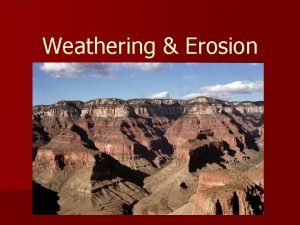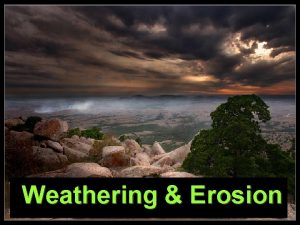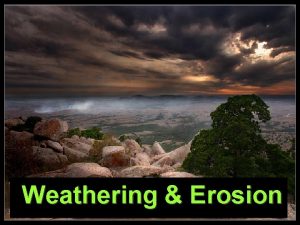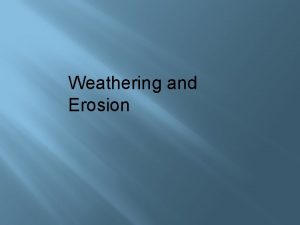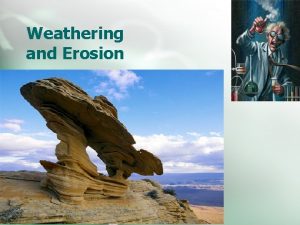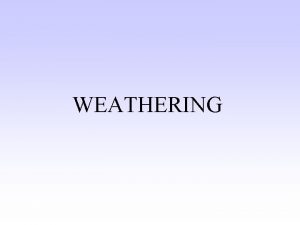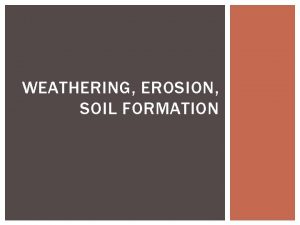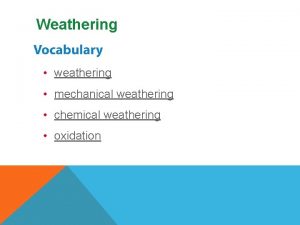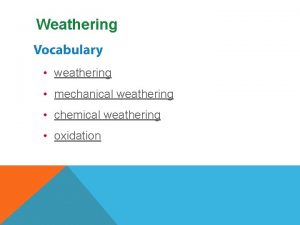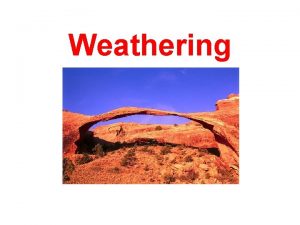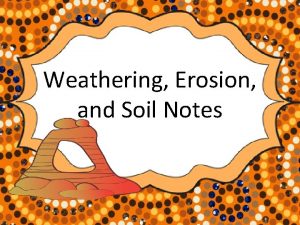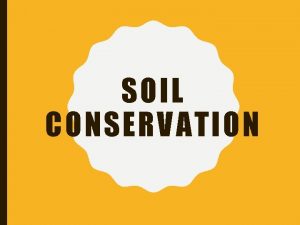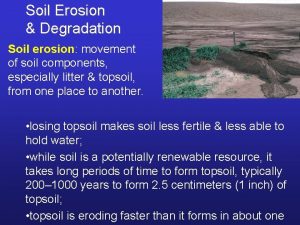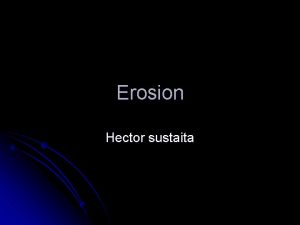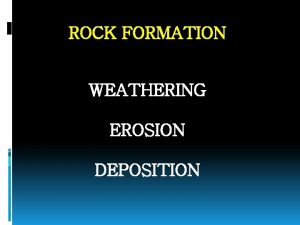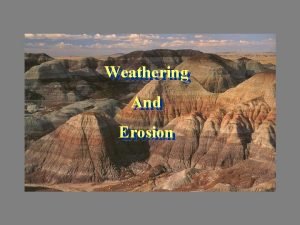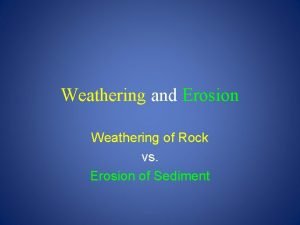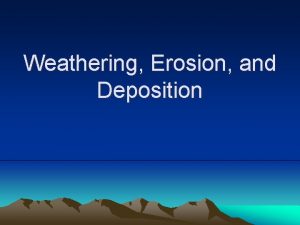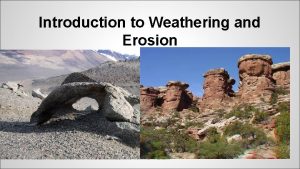Weathering Soil Erosion The type of weathering that



































- Slides: 35

Weathering & Soil Erosion

The type of weathering that #1 occurs when water freezes and thaws in the cracks of rocks eventually breaking the rocks is called • a. chemical • c. ice wedging • b. erosion • d. oxidation

Plants can cause both chemical & mechanical weathering. When a plant causes chemical weathering during the decay process they give off an acid, which part of the plant 2 # gives off the acid? • a. flower • b. roots • c. leaves • d. stem

What type of weathering occurs when chemical reactions dissolve or change #3 the minerals in rocks? • a. erosion • c. mechanical • b. ice wedging • d. chemical weathering

#4 Mechanical weathering is more rapid in __________ climates. • a. colder • b. warmer • c. mountainous • d. dryer

#5 Oxidation can occur when materials containing _________ are exposed to oxygen and water creating rust. • a. magnesium • b. calcite • c. iron • d. hydrogen

#6 When water freezes it ________ which can cause rocks to break apart. • a. expands • c. spills • b. contracts • d. turns into acid

What type of weathering occurs when rocks breaks apart by physical processes? #7 • a. sedimentary • C. mechanical • b. chemical • d. plant acids

#8 Chemical weathering is more rapid in __________ climates. • a. colder, wet • b. Warmer, wet • c. mountainous • d. Cold, dryer

#9 All of the following cause mechanical weathering EXCEPT ____. • a. iron • b. tree roots • c. ice • d. burrowing animals

The roots of a plant can grow through cracks in a driveway, causing the driveway to break. Which kind of #10 process would be occurring? • a. sedimentation • c. erosion • b. weathering • d. exfoliation

#11 The rate of weathering depends upon the area's ____. • a. climate • b. soil • c. oxygen • d. water

The difference between #12 mechanical and chemical weathering is ____. • c. the length of • a. if the chemical time each takes composition of the to break up a rock is changed rock b. that only chemical weathering involves • d. all of the above water

#13 Which of these is an example of how humans positively impact the environment? • a. burning more • c. planting more trees fossil fuel • b. increasing water • d. increasing beach erosion runoff

#14 A man planted trees and shrubs in a bare, empty dirt lot. The roots of the plants can help protect the soil. The soil is most likely being protected from what? • a. earthquake • b. wind erosion • c. water pollution • d. drought

#15 Large pores in soil are most important for _______. • a. making it easier to • c. water and air dig through the soil to move through the soil b. keeping roots from • d. animals to dig moving through the soil

Farmers would purchase manufactured fertilizers because they _____. #16 • a. are the only way to fertilize plants • b. are difficult to wash away with water • c. provide missing nutrients to the soil • d. can easily dry out the soil

#17 When forest trees are cleared from the land, and trees are not replanted; which of the following will most likely occur? • a. sedimentation • c. increase in habitat • b. lightning fires • d. soil erosion

The prairie grass ecosystem once had a deep layer of topsoil which was protected by the grasses that covered it. Removal of these grasses for 8 #1 farmland is causing the soil to be eroded mainly by • a. increased temperature • b. crops growing in the field • c. animal movement • d. wind and rain

Which of the following is not a #19 method that farmers use to prevent soil erosion? • a. contour farming • b. terrace building • c. deforestation • d. no-till farming

Soil erosion occurs _____. #20 • a. where animals eat • c. when forests are away all the plants. • b. on steep slopes. removed. • d. all of the above.

#21 From top to bottom, what are the horizons of soil? • a. Subsoil, bedrock, topsoil • b. Topsoil, bedrock, subsoil • c. Topsoil, subsoil, bedrock • d. Bedrock, subsoil, topsoil

Parts of plants remain on the ground after fields of crops are harvested. #22 Farmers have mixed these plant remains into the soil for many years. This most likely causes _____. • a. the number of organisms in the soil to decrease • c. more minerals to be lost from the fields • b. the organic matter • d. more nutrients in the soil to increase soil to be dissolved

What is the correct rank of #23 particle size (largest to smallest) for the ingredients listed? • a. sand, silt, clay • c. clay, silt, sand • b. sand, clay, silt • d. silt, clay, sand

#24 Plants don't grow as well when ____ has been lost. • a. topsoil • c. parent rock • b. clay • d. slope

#25 Minerals found in the B horizon were dissolved in water and carried there by a process called • a. leaching • b. oxidation • c. weathering • d. littering

#26 The rock and mineral fragments in soil come from rock that has been ____. • a. chemically treated • b. weathered • c. blasted • d. carved

#27 Litter often covers the ____ horizon. • a. A (topsoil) • c. C (bedrock) • b. B (subsoil) • d. all of the above

#28 Soil is a mixture of weathered rock, decayed organic matter, water, air and ____. • a. mineral fragments • b. sand • c. moss • d. clay

#29 The organic matter in humus is made of ____. • a. stems • b. roots • c. dead worms • d. all the above

A __________ is a layer of soil that differs in color and texture from the layers #30 above or below it. • a. bedrock • b. parent rock • c. humus • d. horizon

#31 The C Horizon is directly below _____. • a. A Horizon • c. B Horizon • b. parent rock/ bedrock • d. litter

#32 The B horizon is ____. • c. rockier than • a. where leaching the C horizon begins b. richer in humus • d. lighter in than the A color than the horizon A horizon

#33 Soils in ____ contain little organic material and have a very thin A horizon. • a. temperate forests • b. prairies • c. tropical areas • d. deserts

 Chapter 7 weathering erosion and soil
Chapter 7 weathering erosion and soil Weathering and soil erosion
Weathering and soil erosion Weathering and soil erosion
Weathering and soil erosion Breaking down of rocks
Breaking down of rocks Types of soil erosion
Types of soil erosion Trans pecos weathering
Trans pecos weathering Block nhĩ thất cao độ
Block nhĩ thất cao độ Soil erosion control measures
Soil erosion control measures Soil erosion video
Soil erosion video Soil erosion in india
Soil erosion in india Soil erosion caused by human activities
Soil erosion caused by human activities Soil erosion
Soil erosion Components of soil
Components of soil Soil erosion
Soil erosion As we understand from the reading today soil erosion
As we understand from the reading today soil erosion Soil erosion def
Soil erosion def Agent of erosion
Agent of erosion Factors affecting soil erosion
Factors affecting soil erosion Detachment transportation and deposition
Detachment transportation and deposition Deposition science
Deposition science Phân độ lown
Phân độ lown Thơ thất ngôn tứ tuyệt đường luật
Thơ thất ngôn tứ tuyệt đường luật Thơ thất ngôn tứ tuyệt đường luật
Thơ thất ngôn tứ tuyệt đường luật Chiến lược kinh doanh quốc tế của walmart
Chiến lược kinh doanh quốc tế của walmart Tìm vết của đường thẳng
Tìm vết của đường thẳng Con hãy đưa tay khi thấy người vấp ngã
Con hãy đưa tay khi thấy người vấp ngã Tôn thất thuyết là ai
Tôn thất thuyết là ai Gây tê cơ vuông thắt lưng
Gây tê cơ vuông thắt lưng Sau thất bại ở hồ điển triệt
Sau thất bại ở hồ điển triệt Deposition in edwards plateau
Deposition in edwards plateau What is the difference between weathering and erosion
What is the difference between weathering and erosion Rock erosion
Rock erosion Waves dropping sand on the beach is an example of what
Waves dropping sand on the beach is an example of what Bill nye
Bill nye Hydrolysis weathering definition
Hydrolysis weathering definition Weathering and erosion difference youtube video
Weathering and erosion difference youtube video
